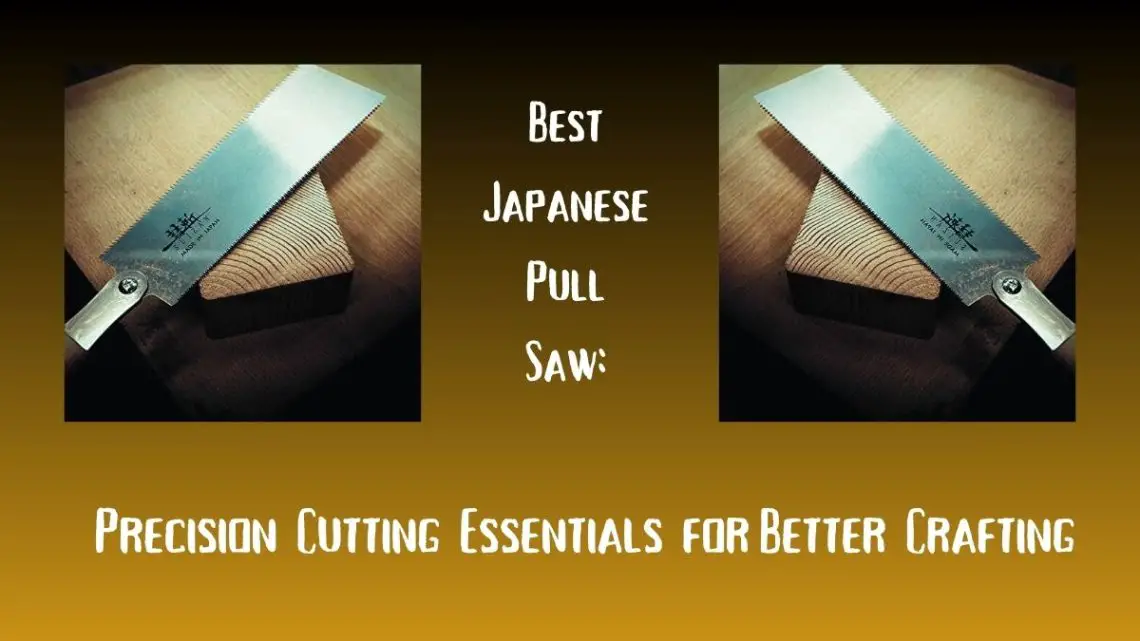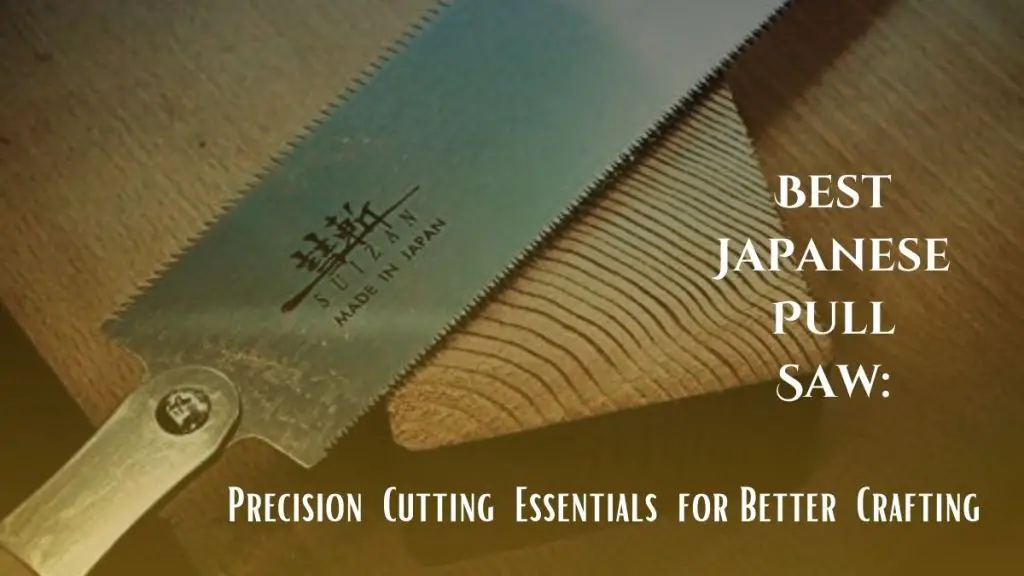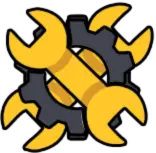
Best Japanese Pull Saw: Precision Cutting Essentials for Better Crafting
The best Japanese pull saw is the Suizan 9.5-inch Ryoba Double Edge Japanese Pull Saw. This tool excels in precision woodworking tasks.
Japanese pull saws, known for their fine cuts and thin blades, have become a staple in modern workshops. The Suizan Ryoba pull saw, a standout among these tools, offers exceptional control and accuracy. Crafted with a durable and sharp steel blade, it allows woodworkers to make both rip and crosscuts with ease.
The traditional design of the handle ensures a balanced grip, which is vital for making consistent and straight cuts. Perfect for intricate joinery work, the Suizan saw remains a favorite for its versatility and clean cutting ability. Offering the agility needed for delicate tasks, yet tough enough for daily use, this saw is a top choice for professionals and DIY enthusiasts alike.
Related Article: The 11 Basic Hand Tools Safety Rules for Professional Users

Related Article: The 7 Best Scroll Saws of 2024 for Professional Workers
The Art of Japanese Woodworking
The Art of Japanese Woodworking is a mesmerizing journey through time, technique, and tradition. These masterpieces are not created with haste; they are the results of patient precision and delicate detailing. Central to this craft are Japanese saws, tools that cut with fineness unmatched by their Western counterparts.
Japanese saws, known as Nokogiri, are key players in the woodworking realm. The blades tell tales of careful creation, from intricate joinery to fine furniture.
Influence Of Japanese Saws
Japenese pull saws, or Nokogiri, hold a distinguished place. Their pull stroke differs from the Western push saws. This pull action gives us control and accuracy. Below are key influences:
- Less effort in each cut
- Thinner blades mean smoother cuts
- Ability to create complex joinery without power tools
Essentials Of Precision Cutting
In Japanese woodworking, precision is paramount. The artisans’ repertoire includes Dozuki and Kataba saws. Each saw has its unique role:
| Saw Type | Use |
| Dozuki | Delicate cuts, dovetails |
| Kataba | Deep cuts, tenons |
Such precision tools allow for clean lines and sharp finishes, vital in Japanese craft.

Credit: www.amazon.com
Japanese Pull Saw Defined
The Japanese pull saw, known in Japan as a “nokogiri,” stands out in the carpentry world. Unlike Western saws, it cuts materials by pulling rather than pushing. This unique action allows for finer, more precise cuts. Craftsmen favor it for its control and accuracy.
Design Characteristics
- Thin Blade: The blade is slimmer and more flexible than push-stroke saws.
- Teeth Configuration: Teeth are designed to cut on the pull stroke.
- Handle: Long, straight handles provide a steady grip and control.
Japanese pull saw blades are replaceable, adding to their convenience and longevity.
Types And Uses
| Type of Saw | Main Use |
| Dozuki | Finest cuts, ideal for joinery |
| Ryoba | Double edged for crosscutting and ripping |
| Kataba | General purpose, good for larger cuts |
Each type serves a specific function, making them versatile tools for various projects.
Key Features To Consider
Choosing the perfect Japanese pull saw requires understanding its key features. We must consider what makes one saw stand out from another. Let’s delve into specifics that can guide your purchase.
Blade Material And Durability
Blade quality is critical for any saw’s performance. Japanese pull saws have thin, flexible blades often made from high-carbon steel. This material ensures sharpness and a long-lasting edge. Look for saws with impulse-hardened tips for extra durability. Some premium saws feature a layered blade with a soft metal core and hard outer layer, providing both flexibility and strength.
Handle Ergonomics
The saw handle impacts your comfort and control when cutting. A well-designed handle should feel natural in your grip. Traditional Japanese pull saws have a cylindrical handle wrapped in rattan or rubber. Modern variations might feature a contoured, padded grip to reduce fatigue and improve your hold.
Tpi (teeth Per Inch) Explained
Different cutting tasks require different TPIs. The TPI determines how fine or aggressive the cut is. Here’s a simple breakdown:
- Lower TPI (6-8): For fast, rough cuts in soft wood.
- Medium TPI (14-18): Offers a balance, suitable for general purposes.
- Higher TPI (20+): For fine, detailed cuts in hardwood.
Select the TPI based on the project needs.
Top-ranked Japanese Pull Saws
Japanese pull saws elevate precision in woodworking. These saws cut on the pull stroke. This unique design reduces effort and increases control. Craftsmen worldwide choose them for their sharpness and thin kerf. We’ll dive into the top-ranked Japanese pull saws available today.
Professional Reviews
Experts have tested various models to offer insights. They prioritize blade quality, handle ergonomics, and cutting efficiency. Findings reveal key players stand out in the industry.
- SUIZAN Japanese Ryoba Pull Saw – A dual-edge powerhouse, top in versatility.
- Gyokucho Razorsaw Flush Cutting Double Edge Saw – Renowned for its flush cuts.
- Dozuki “Z” Saw – A favorite for joinery with its stiff spine.
User Experiences
User feedback often reflects real-world use. Happy customers note the ease of use and durability of these saws. Online reviews and forums like Reddit contribute to these insights.
| Saw Model | Key Strength | User Rating |
| SUIZAN Ryoba | Two cutting edges | 4.7/5 |
| Gyokucho Razorsaw | Superior flush cutting | 4.5/5 |
| Dozuki “Z” Saw | Precision joinery | 4.6/5 |
Personal stories emphasize the smoothness of the cut and low fatigue levels. Craftsmen admire the minimal tear-out and clean finish these saws leave behind.
Maintaining Your Pull Saw
A Japanese pull saw demands meticulous care to maintain its sharp edge and precision cutting power. Understanding the proper methods to clean, store, and sharpen your tool will extend its life and optimize performance.
Cleaning And Storage Tips
Keeping your pull saw clean and safely stored is essential. Begin by wiping the blade with a clean cloth after each use. This removes any residue and prevents rust. For sap or resin, use a solvent like mineral spirits followed by a dry cloth. It’s important to avoid touching the blade with bare fingers; the oils from your skin can promote rust.
- Wipe the blade after use
- Clean with mineral spirits for tough residues
- Avoid direct skin contact with the blade
Store your saw in a dry environment, ideally in its original case or a custom-made sheath. Hang it on a tool rack or place it in a drawer where the blade won’t contact other tools and remains straight. Keep it out of direct sunlight and away from moisture.
Sharpening Techniques
Sharpening a Japanese pull saw requires skill and the right tools. Unlike push saws, only the tip of the teeth should touch the sharpening file. The process is delicate, as the teeth are finer and more prone to breaking.
| Step | Action |
| 1 | Secure the saw |
| 2 | Use the correct file |
| 3 | File gently |
| 4 | Follow the tooth pattern |
| 5 | Check for uniform sharpness |
Always start at the far end of the blade, filing toward the handle. The motion should be smooth and controlled. After every few strokes, take a moment to check the sharpness. Consistency is key, and each tooth should be sharpened with the same number of strokes.

Credit: www.amazon.com
Common Mistakes To Avoid
Mastering the use of a Japanese pull saw requires skill and practice. Even skilled woodworkers can make mistakes. It’s essential to avoid common errors to ensure clean cuts and extend the life of your saw.
Improper Handling
A Japanese pull saw is not just any saw. It operates on a pull stroke, not a push. Improper handling can lead to breakage. Keep these tips in mind:
- Use less force. Let the saw do the work.
- Keep your wrist straight. This prevents bending.
- Guide the saw smoothly. Jerky movements can damage it.
- Support the piece being cut. This avoids unnecessary strain on the blade.
Incorrect Blade Choices
Selecting the right blade is crucial for the task at hand. Each blade has its purpose.
| Blade Type | Use Case |
| Ryoba | Crosscutting and ripping |
| Dozuki | Precision joinery |
| Kataba | General cuts without a back |
- Avoid using a fine-toothed blade on thick material.
- Do not use a crosscut blade for rip cuts.
- Replace the blade when it dulls. A dull blade requires more force.
Pull Saw Techniques And Tips
Japanese pull saws, known for their precision and clean cuts, stand out in the world of woodworking tools.
Embracing the right techniques is key to unlocking their potential.
This guide will explore essential pull saw methods, sharpening your skills.
Mastering The Pull Stroke
The essence of a pull saw is its pull stroke action.
- Grip the handle firmly, positioning your index finger along the side for better control.
- Begin with gentle pulls to establish your cut line, avoiding forceful pushes.
- Keep the saw’s blade straight and allow its teeth to do the work.
- Adopt steady, consistent pulls for smooth, straight cuts.
- Relax your grip slightly on the return stroke to preserve the blade’s sharpness.
These steps help preserve the saw and ensure precise cuts.
Advanced Cutting Methods
Once you master the pull stroke, explore these advanced techniques.
| Method | Application |
| Kerfing | Establish a narrow guide before deep cuts. |
| Cross-Cutting | Use a slicing motion across the grain. |
| Rip-Cutting | Cut along the wood grain with longer strokes. |
| Angled Cuts | Position saw for bevels or miter cuts. |
Each technique requires practice and steady hands for the best results.
Don’t rush the process.
Take time to understand these methods.
Choosing The Right Pull Saw For You
Welcome to the delicate art of selecting the perfect Japanese pull saw for your woodworking projects. With a range of styles and features, finding one that fits your specific needs can elevate your craftsmanship to new heights. Let’s dive into the process of picking a saw that feels like it was made just for you.
Identifying Your Needs
Understanding what makes a pull saw ideal for you begins with a clear picture of your projects. Pull saws, known as ‘Nokogiri’ in Japan, come in different forms for various tasks.
- Dozuki – Best for fine, precise cuts.
- Ryoba – Offers dual-edge flexibility, one for cross-cutting and one for rip-cutting.
- Kataba – No back spine allows for deeper cuts.
Consider the materials you will be cutting, the precision required, and how often you’ll use the saw. A craftsman focusing on delicate joinery might choose a Dozuki, while a Kataba might be suitable for deeper timber cuts.
Comparative Shopping
With your needs in mind, comparing different pull saws is your next step. Look for high-quality steel blades and comfortable handles. A well-balanced saw ensures controlled cutting.
| Feature | Consideration |
| Blade Thickness | Thinner blades for precision work, thicker for general tasks. |
| Tooth Count | Higher count for finer cuts, lower for rougher, fast work. |
| Handle Grip | Ergonomic designs reduce fatigue over long use. |
Price, brand, and reviews are also important factors. Researching and reading testimonials from other woodworkers provides insight into performance and durability. Balance cost with the quality and features that meet your woodworking requirements.
Future Of Precision Cutting Tools
The evolution of cutting tools shapes modern craftsmanship. Skilled artisans and DIY enthusiasts seek tools that combine tradition with technology. This is especially true for the Japanese pull saw, renowned for its fine cuts and effortless precision. The future points towards tools that are not only efficient but also innovative and user-friendly. Let’s dive into how these saws are advancing in design and utility.
Innovation In Saw Manufacturing
The art of saw making stands on the brink of transformation. New materials and engineering practices bring forth lighter, stronger, and more durable saw blades. Innovations like laser-cutting technology and micro-milling enhance the sharpness and lifespan of saws. Developers use advanced metallurgy and ergonomic design to ensure superior performance and comfort.
- Laser-cut tooth patterns for unmatched precision
- Non-slip handles shaped for grip stability
- Blade tensioning systems for consistent cutting pressure
Emerging Brands And Products
New competitors in the market are redefining excellence. Emerging brands are not afraid to challenge the status quo, introducing pull saws with groundbreaking features. Customers now have access to a diverse range of products, each promising to enrich the cutting experience.
| Brand | Feature | User Experience |
| Kizaku | Triple-edge teeth | Smooth, fast, and clean cuts |
| Shinrai | Interchangeable blades | Versatile and cost-effective |
| Narabi | Carbon composite spine | Reduced blade flex, precise control |
Let’s celebrate the dawning era of Japanese pull saws. They continue to revolutionize woodworking, making every slice a testament to the intersection of heritage and innovation.

Credit: www.manmadediy.com
Frequently Asked Questions For Best Japanese Pull Saw
Are Japanese Pull Saws Any Good?
Japanese pull saws are highly effective for precision woodworking, offering clean cuts with their finely toothed blades and pull-stroke action. Their design reduces effort and enhances control, making them a popular choice for craftsmen.
Which Japanese Saw Is Best?
The best Japanese saw depends on the task, but the Gyokucho Razorsaw Ryoba is a top choice for its versatility and quality.
What Is Kataba Vs Ryoba Vs Dozuki?
Kataba, ryoba, and dozuki are types of Japanese saws. Kataba has a single-edged blade for deep cuts, ryoba features double edges for cross and rip cuts, and dozuki is used for precise, fine cuts with its thinner blade and reinforced spine.
What Is The Benefit Of A Japanese Pull Saw?
A Japanese pull saw offers precise, clean cuts with less effort due to its thin, sharp blade that cuts on the pull stroke.
Best Japanese Pull Saw In 2024>>
Conclusion
Selecting the perfect Japanese pull saw enriches your toolkit, ensuring precise, clean cuts for your woodworking projects. Remember to consider blade type, handle comfort, and durability when making your choice. Arm yourself with the right saw and turn every piece of wood into a masterpiece with efficiency and artistry.
Happy crafting!
You may also read: Types of Pliers and Their Uses You Must Know




